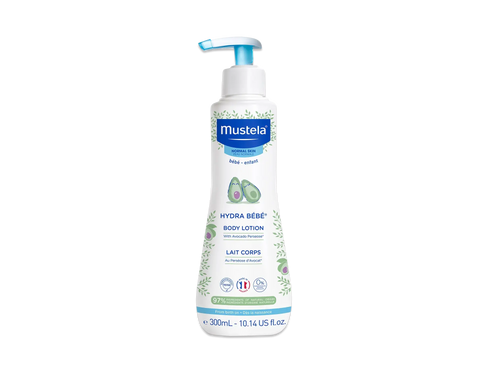Your tiny, precious baby might not be able to verbally communicate that they have an empty belly, but they can certainly give you other clues! All you have to do is learn to read the signs that your baby is hungry.
There are several typical ways that babies express themselves when they are ready to eat. In this article, we’ll tell you about eight signs that your baby is hungry and discuss a few of the ways you can know they’re full.
But first, let’s talk about a very important aspect of learning baby hunger cues: getting to know your baby.
Get To Know Your Baby
Just like adults, every baby is different. While there are some hunger cues that many babies have in common, you’ll need to get to know your baby and their unique way of communicating that they’re ready to eat.
That said, it’s helpful to know the typical signs that a baby is hungry and use this knowledge along with the knowledge about your own little one.
8 Signs Your Baby Is Hungry

1) Crying
Crying might seem like an obvious hunger cue. But it’s important to note that it’s actually a late cue. If a baby starts wailing because they want to eat, it means they’re really hungry.
To prevent them from getting to this point, it’s better if you can catch earlier signs your baby is hungry and feed them before the crying starts.
2) Alertness
One sign that your baby might be hungry is that they’re alert and active with their eyes open. This may mean that your little one is excited and ready to chow down.
3) Turning Toward The Breast
When your baby is turning their head toward your breast, looking for their next meal, take this as a clue that it’s time to nurse or bottle-feed.
4) Smacking Lips
If you pay close attention, you might see your baby puckering, smacking, or licking their tiny, rosy lips. This is an indication that they are looking to latch.
5) Opening And Closing Their Mouth
Similarly, your baby might open and close their mouth as another sign of hunger. Seize the moment to offer them their next meal!
6) Restlessness
Babies can be fussy for a variety of reasons, and hunger is one of them. Try offering a bottle or your breast the next time your baby becomes restless, squirmy, or fussy.
7) Clenched Fists
Clenched fists may also indicate that your little one is hungry. After all, we adults can get tense when we are hungry, too!
8) Sucking On Fingers Or Hands
Your baby sucking on their fingers or hands is the last sign we’ll mention. But you should know that this is not a foolproof hunger cue for a baby that’s more than a couple of months old.
By this age, they’re discovering the control they have over their body and may bring their hands to their mouth just to explore.
Signs An Older Baby Is Hungry

Sometimes reading infant hunger cues can feel like deciphering a code. It’s easier when your baby is a bit older, begins to eat solid food, and uses words or sign language.
Here are a few signs your older baby is hungry.
Reaching For Food
Once your baby can sit, roll over, and the like, they’re more capable of getting where they need to go and to what they want! Take it as a clear clue that they are hungry if your baby reaches for, points at, or moves toward food.
Specific Words Or Signs
As you get to know your ever-changing baby, you may learn that your little one makes a certain sound or says a specific word when they’re ready to eat. Even if your baby doesn’t have any words yet, they can make a sign to tell you their belly is rumbling.
Looking Happy When They See Food
Even babies get happy when they see food they want! If your baby is smiling, cooing, and happy when you show them food, definitely take it as a hunger sign.
Eating Eagerly When Offered Food
Similarly, you can assume your baby is hungry when they open their mouth in anticipation and eat eagerly when offered food.
Signs Your Baby Is Full

Just as it’s important to be familiar with the signs that your baby is hungry, it’s also helpful to know when they’re full and satisfied.
Turning Away
We mentioned that your baby turning toward the breast is a hunger cue. Likewise, your baby releasing the nipple or turning away from the milk source (whether it’s breast or bottle) can be a sign that they are full.
Relaxed Hands
Once your baby is satisfied, their body will be more at ease. You may see that their hands are relaxed and open at this point.
Slowing Down
When nursing or bottle-feeding, your baby may be getting full once their sucking slows down or they become easily distracted.
Sleeping
Who doesn’t like a nap after a good meal? You may find that your baby with a full tummy contentedly dozes off after eating.
Refusing Food
Lastly, when your baby is full, they may simply turn up their nose at more. An infant might turn their head away, while an older baby may close their mouth, push the food away, or sign or say that they’re finished.
Taking Care Of Yourself While Breastfeeding

We’ve mentioned signs your baby is hungry and signs your baby is full, but before we wrap up, we’d like to discuss an important aspect of feeding your baby: taking care of yourself.
Self-care is important for all parents, but if you’re breastfeeding, it’s a priority to look out for and take care of yourself and your skin. We know that, while breastfeeding is a wonderful connection between mother and baby, it’s not always a walk in the park.
There’s a lot we could say about the beauty and benefits of nursing and the necessity of self-care while you do it, but we’ll just focus on these two tips today.
Help Your Baby Latch
We cannot adequately express the importance of a good breastfeeding latch! When your baby doesn’t latch onto your nipple well, they may not get enough milk, which is not good for your baby’s development and can also decrease your milk supply.
Plus, a bad latch can also hurt you. If you’re in pain when breastfeeding, this could be a sign that your little one isn’t latching on correctly, and it could cause sore or cracked nipples. Ouch!
The good news is that you and your baby can work together to achieve a comfortable latch. In this article here, we share 13 tips for a good breastfeeding latch, but don’t hesitate to reach out to a lactation consultant if you need additional support.
Soothe Your Nipples

The other way to take care of yourself as a breastfeeding mom is to tend to and soothe your nipples with a cream, like our Nursing Comfort Balm. This restorative nipple cream moisturizes and protects your nipples, eases discomfort, and keeps your skin comfortable while nursing.
Made with 100% naturally derived food-grade ingredients, including olive oil and plant-based glycerin, this lanolin-free balm is enriched with vitamin E to nourish and protect your skin. You can also rest assured that it's vegan, fragrance-free, and dye-free.
Our nipple cream is backed by scientific research, developed in collaboration with healthcare professionals, and tested under dermatological control. It’s safe for you and your little one and, just like all Mustela products, contains no parabens, phthalates, or phenoxyethanol.
To use, apply the cream generously to your nipples after nursing. There’s no need to rinse. Simply be sure to clean your nipples before each breastfeeding session.
Read more about naturally soothing your nipples here. And, to make your experience as pleasant as possible, try different breastfeeding positions until you are your baby are really in the groove.
Learning Your Little One

Although each baby will express themselves a bit differently, the hunger cues we mentioned in this article will help you identify when your little one is ready to eat. Take those cues into account and observe your baby to learn the specific signs they show when they’re hungry.
Learning how to anticipate your baby’s needs is part of getting to know this new member of your family!
As you do so, don’t forget to take care of yourself, especially if you are a breastfeeding mom. When breastfeeding, work with your baby to achieve a good latch, and turn to our Nursing Comfort Balm to moisturize and protect your nipples.
(Bonus: our Nursing Comfort Balm can also be used to soothe and moisturize dry lips!)
With all of this expert knowledge under your belt, it’s time to go out there and conquer the baby world. Here’s to health, happiness, and full tummies!










